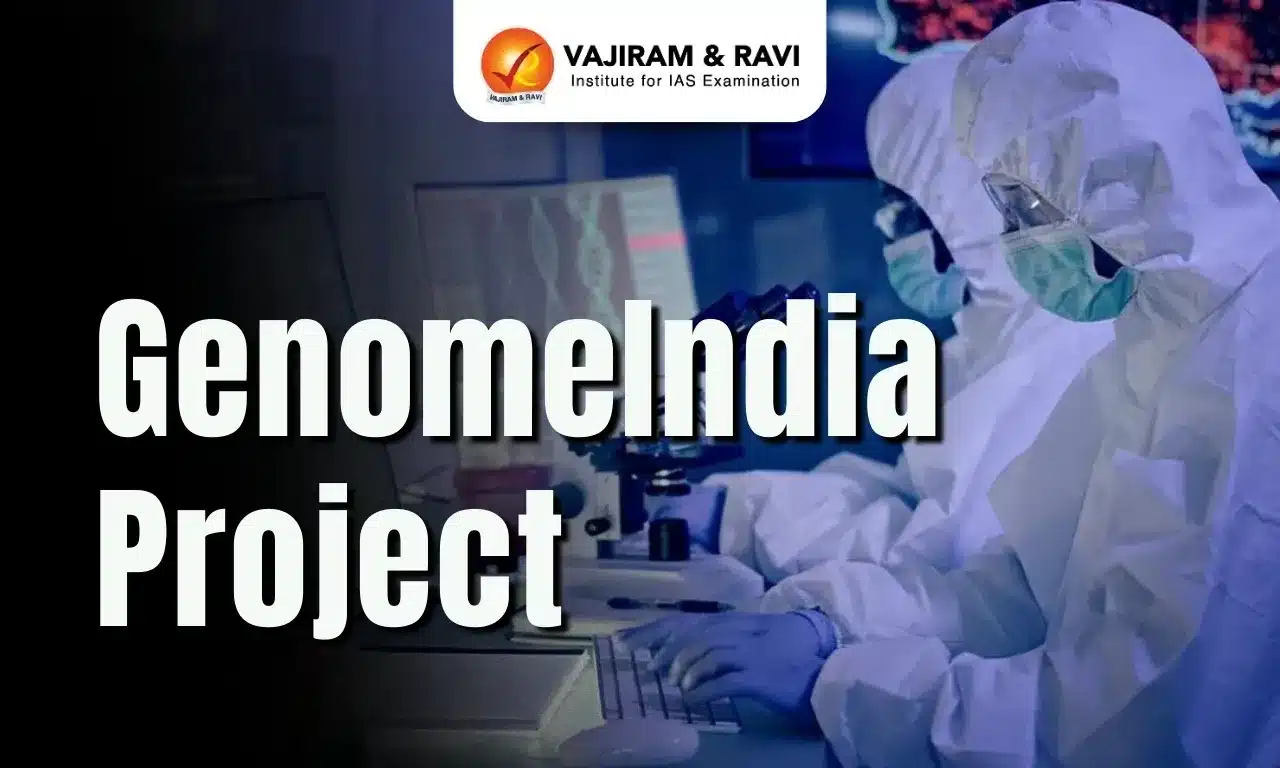What’s in Today’s article?
- Genome India project Latest News
- Launch of Genome India project
- Sampling Strategy
- Key Genetic Findings
- Genome India Project FAQ’s
Genome India project Latest News
- The preliminary findings of the Genome India project, which aimed to sequence the whole genomes of 10,000 healthy and unrelated Indians from 83 population groups, were published in Nature Genetics.
- After excluding two population groups, the study analyzed data from 9,772 individuals, including 4,696 men and 5,076 women.
Launch of Genome India project
- The Genome India project was launched in January 2020, with funding from the Department of Biotechnology.
- Scope and Sample Collection
- The study aimed to collect blood samples and phenotype data (e.g., weight, height, hip & waist circumference, blood pressure).
- Participants represented 83 population groups: 30 tribal; 53 non-tribal.
- These groups were spread across India.
- Genome Sequencing
- Whole genome sequencing was performed on DNA samples from 10,074 individuals.
- After excluding two populations, data from 9,772 individuals was analyzed.
- Collaborating Institutions
- The project is a collaborative effort involving 20 institutions. Genome sequencing was carried out by:
- Centre for Brain Research, IISc Bengaluru
- Centre for Cellular and Molecular Biology, Hyderabad
- Institute of Genomics & Integrative Biology, Delhi
- National Institute of Biomedical Genomics, Kolkata
- Gujarat Biotechnology Research Centre, Gandhinagar
- The project is a collaborative effort involving 20 institutions. Genome sequencing was carried out by:
Sampling Strategy
- Samples were collected from 83 population groups across 100+ distinct geographical locations.
- Median samples collected:159 individuals per non-tribal group; 75 individuals per tribal group.
- Participants were unrelated to ensure accurate estimation of mutation frequencies.
- Parent-Child Pairs
- 3 to 6 parent-child pairs were included in each group.
- Purpose: To detect de novo mutations (mutations present in a child but absent in parents).
- Tribal and Non-Tribal Genome Coverage
- Tribal groups sequenced:
- Tibeto-Burman tribe
- Indo-European tribe
- Dravidian tribe
- Austro-Asiatic tribe
- Continentally admixed outgroup
- Non-tribal groups sequenced:
- Tibeto-Burman non-tribe
- Indo-European non-tribe
- Dravidian non-tribe
- Tribal groups sequenced:
- Linguistic Representation
- Sampling aligned with India’s major language families, which correlate with genetic diversity:
- Indo-European
- Dravidian
- Austro-Asiatic
- Tibeto-Burman
- Sampling aligned with India’s major language families, which correlate with genetic diversity:
- Excluded Populations
- Four ancient Andamanese populations (dating back ~65,000 years)
- Two relatively modern populations (from ~5,500 years ago)
Key Genetic Findings
- 180 million mutations identified in total:
- 130 million in autosomes (non-sex chromosomes)
- 50 million in sex chromosomes (X and Y)
- The large number is expected, given the 3 billion DNA base pairs and sequencing of 9,772 individuals from 83 distinct endogamous groups.
- 98% of the human genome consists of non-coding regions, and most variants are likely found here.
- Non-coding region mutations, especially evolutionarily conserved polymorphisms, help in tracing human evolutionary history.
- This is especially important in India, where many contemporary populations stem from a few founding groups and have remained genetically distinct due to endogamy.
- Impact of Endogamy
- All 83 groups studied practice endogamy, though to varying degrees.
- Long-term endogamy has led to population-specific unique mutations, including disease-causing genetic variants with amplified frequencies.
- India’s genetic diversity has been underrepresented in global (largely Eurocentric) genome studies.
- This project addresses that gap by capturing the genetic landscape of one of the most diverse populations globally.
- Medical Implications
- The findings will encourage studies on genetic links to diseases specific to Indian populations.
- It promotes precision medicine, allowing for personalized treatment strategies tailored to Indian genetic make-up.
- Enables development of affordable diagnostic tools for early disease detection, prevention, and management in India.
- Findings can support targeted public health policies to address population-specific genetic disorders.
Genome India Project FAQs
Q1. What is the Genome India project?
Ans. It is a nationwide genome sequencing initiative to map genetic diversity in 10,000 unrelated Indians across 83 population groups.
Q2. When was the Genome India project launched?
Ans. It was launched in January 2020, funded by the Department of Biotechnology, to understand India’s genetic diversity and diseases.
Q3. What were the key findings of Genome India?
Ans. The study found 180 million mutations, mostly in non-coding DNA, highlighting India’s distinct genetic profile due to endogamy.
Q4. Why is endogamy significant in Genome India?
Ans. Endogamy led to unique, population-specific mutations that help trace evolution and identify group-specific disease risks for precision healthcare.
Q5. What are the health benefits of Genome India?
Ans. It enables development of tailored diagnostics, early disease detection, and precision medicine based on Indian genetic profiles.
Source: TH
Last updated on June, 2025
→ UPSC Notification 2025 was released on 22nd January 2025.
→ UPSC Prelims Result 2025 is out now for the CSE held on 25 May 2025.
→ UPSC Prelims Question Paper 2025 and Unofficial Prelims Answer Key 2025 are available now.
→ UPSC Calendar 2026 is released on 15th May, 2025.
→ The UPSC Vacancy 2025 were released 1129, out of which 979 were for UPSC CSE and remaining 150 are for UPSC IFoS.
→ UPSC Mains 2025 will be conducted on 22nd August 2025.
→ UPSC Prelims 2026 will be conducted on 24th May, 2026 & UPSC Mains 2026 will be conducted on 21st August 2026.
→ The UPSC Selection Process is of 3 stages-Prelims, Mains and Interview.
→ UPSC Result 2024 is released with latest UPSC Marksheet 2024. Check Now!
→ UPSC Toppers List 2024 is released now. Shakti Dubey is UPSC AIR 1 2024 Topper.
→ Also check Best IAS Coaching in Delhi























